What Is the GD9FU4G8F3AMGl Memory Chip and Its Main Features
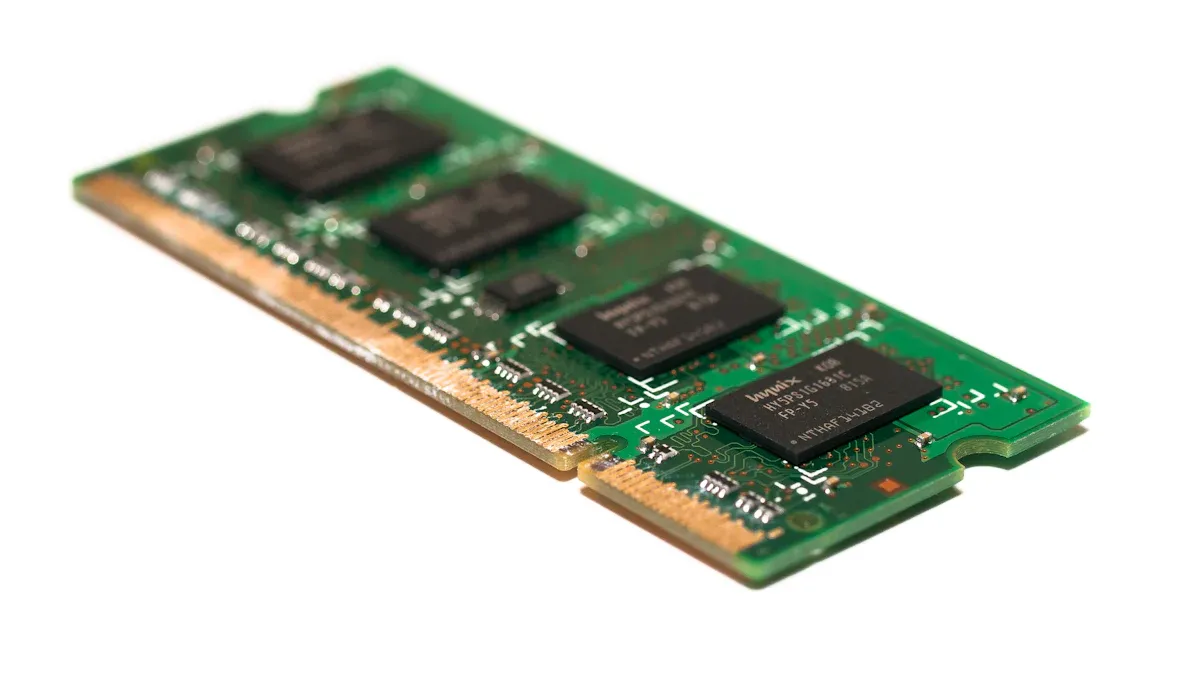
The GD9FU4G8F3AMGl memory chip stores digital information in electronic devices. This chip helps systems run smoothly by managing data quickly and reliably. Users and buyers benefit from knowing its main features because these details affect device performance, compatibility, and energy use. Understanding the chip’s specifications leads to better choices for any project.
Key Takeaways
The GD9FU4G8F3AMGl memory chip stores and manages data quickly to help devices run smoothly.
Choosing the right chip means checking its speed, memory size, voltage, and compatibility with your device.
Faster memory speeds and larger sizes improve device performance and allow smoother multitasking.
Lower voltage chips save energy, reduce heat, and extend battery life in mobile and portable devices.
Ensuring the chip fits your system’s form factor and supports error correction keeps your device stable and reliable.
GD9FU4G8F3AMGl Overview
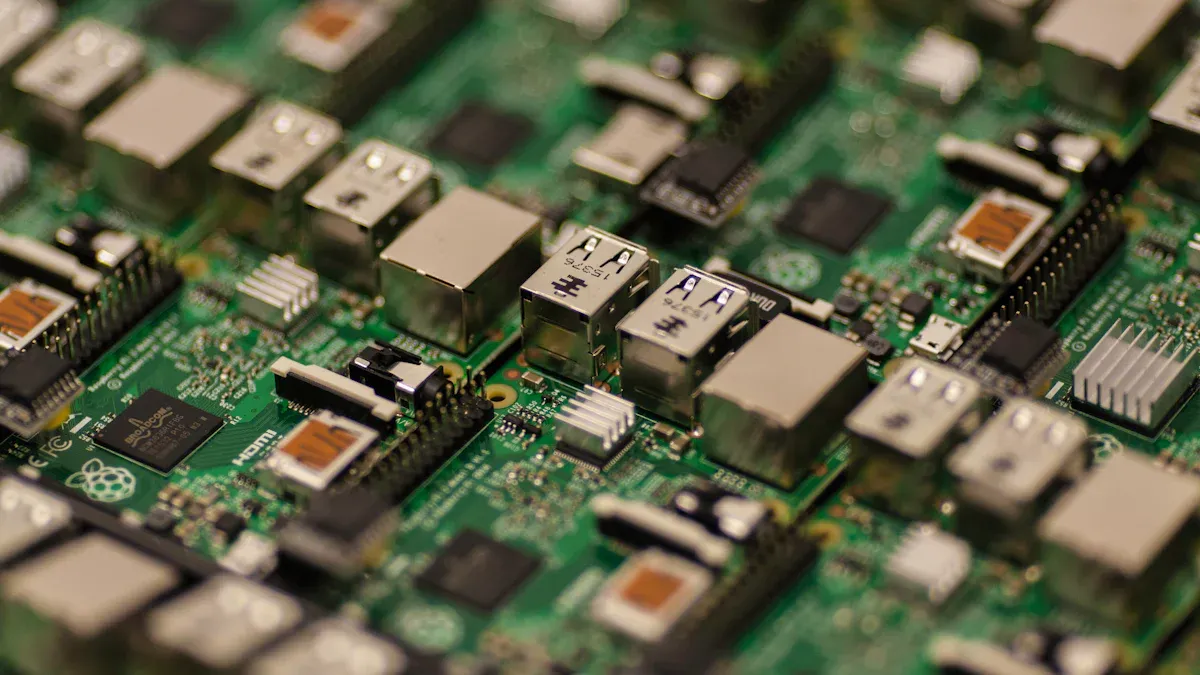
The GD9FU4G8F3AMGl serves as a memory chip in electronic devices. While detailed public data about this specific chip is limited, users can identify memory chips like this by checking features such as error correction code (ECC) support, chipset compatibility, form factor, speed, voltage, and package type. These identification methods help ensure the chip fits the system and works reliably.
Chip Type
Memory chips come in several types, each with unique features. The table below shows the most common types found in modern electronics:
Memory Type | Description | Volatility | Typical Applications | Key Characteristics |
|---|---|---|---|---|
DRAM | Volatile memory used in computers | Volatile | Laptops, desktops, servers | High density, cost-effective |
SRAM | Faster, more stable than DRAM | Volatile | CPU cache, routers | Fast access, low power |
Flash Memory | Retains data without power | Non-volatile | SSDs, USB drives, phones | Persistent, slower than DRAM |
EEPROM | Programmable and erasable | Non-volatile | Config storage, microcontrollers | Byte-level erase, limited writes |
MRAM | Uses magnetic storage | Non-volatile | High-performance, industrial | Fast, high endurance |
The GD9FU4G8F3AMGl likely falls into one of these categories, but exact details are not available.
Manufacturer
Many companies produce memory chips similar to the GD9FU4G8F3AMGl. Some well-known manufacturers include:
Samsung
Micron
SK Hynix
KIOXIA (Toshiba)
Western Digital
GigaDevice
Nanya Technology
Shenzhen Ruichenyu Technology Co., Ltd.
Shenzhen Misuxin Electronics Co., Ltd.
These companies have strong reputations for quality and innovation in the memory chip industry.
Intended Use
Memory chips like the GD9FU4G8F3AMGl store and manage data in many devices. They appear in consumer electronics such as smartphones, tablets, and laptops. Automotive systems use them for infotainment and safety features. Industrial controllers and IoT devices rely on memory chips for fast data access and reliable storage. The choice of chip depends on the device’s need for speed, power efficiency, and data retention.
Note: Buyers should always check compatibility, ECC support, and system requirements before selecting a memory chip. This helps avoid integration problems and ensures the device works as expected.
Specifications
Memory Size
Memory size tells how much data a chip can store at one time. For chips like the GD9FU4G8F3AMGl, memory size often ranges from 1GB to 128GB. Larger memory sizes help devices handle more data, run bigger programs, and work faster in demanding tasks like gaming or video editing.
Memory Category | Standard Memory Sizes | Usage Scenarios | Impact on Device Performance |
|---|---|---|---|
GDDR6 | 1GB, 2GB, 4GB, 8GB, 16GB, 32GB, 64GB, 128GB | Gaming consoles, high-end gaming PCs, professional workstations, real-time rendering, machine learning | Higher capacities (32GB and above) enable handling larger data volumes, significantly enhancing performance and efficiency in demanding applications. High bandwidth (up to 16 Gbps per pin) supports fast data access and processing, crucial for graphics-intensive tasks. |
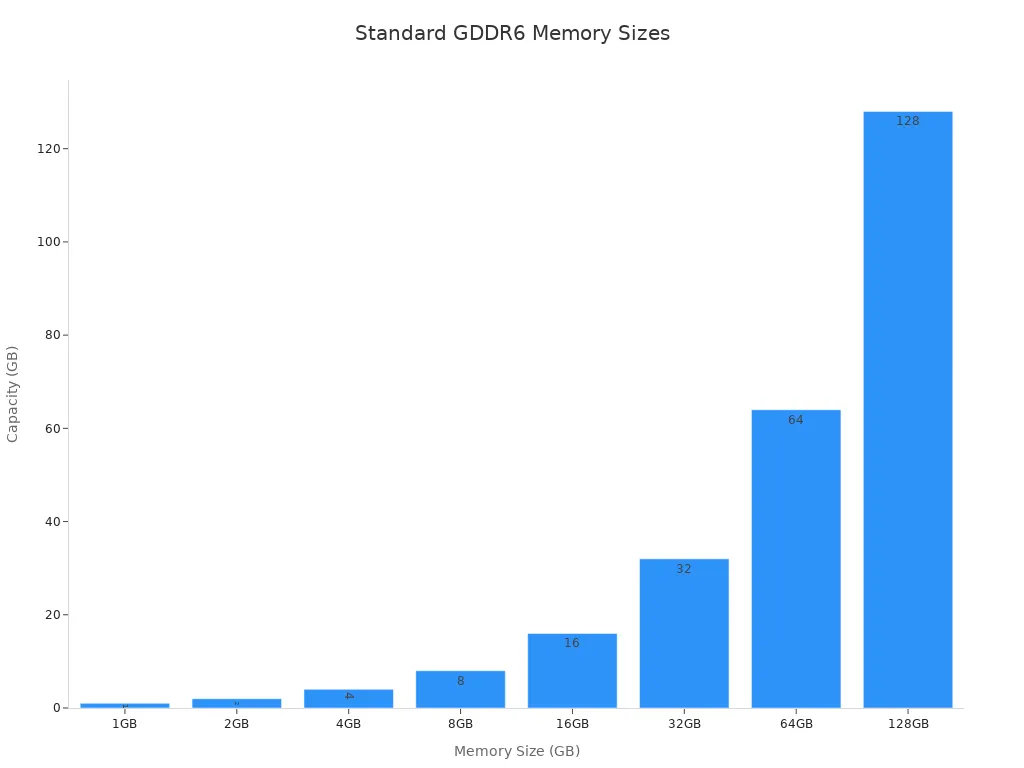
Tip: Devices with more memory can run more apps at once and process bigger files without slowing down.
Speed
Speed measures how fast the memory chip can move data. Faster speeds mean the chip can send and receive information quickly, which helps computers and devices respond faster. The GD9FU4G8F3AMGl, as a GDDR6 chip, can reach speeds up to 16 Gbps per pin. This high speed is important for tasks like gaming, artificial intelligence, and video editing.
Memory Type | Typical Data Transfer Speeds | Impact on System Efficiency |
|---|---|---|
DDR4 | 1600 - 3200 MT/s | Improves data access times and responsiveness in desktops, laptops, and servers |
DDR5 | Starting at 4800 MT/s | Enables higher bandwidth and power efficiency for high-performance computing and gaming |
LPDDR4 | Up to 3200 Mbps | Balances performance and low power consumption for mobile and embedded systems |
LPDDR5 | Up to 6400 MT/s | Enhances power efficiency and bandwidth for mobile devices and AR/VR applications |
GDDR6 | Up to 16 Gbps per pin | Provides very high bandwidth for GPUs, critical in gaming and AI workloads |
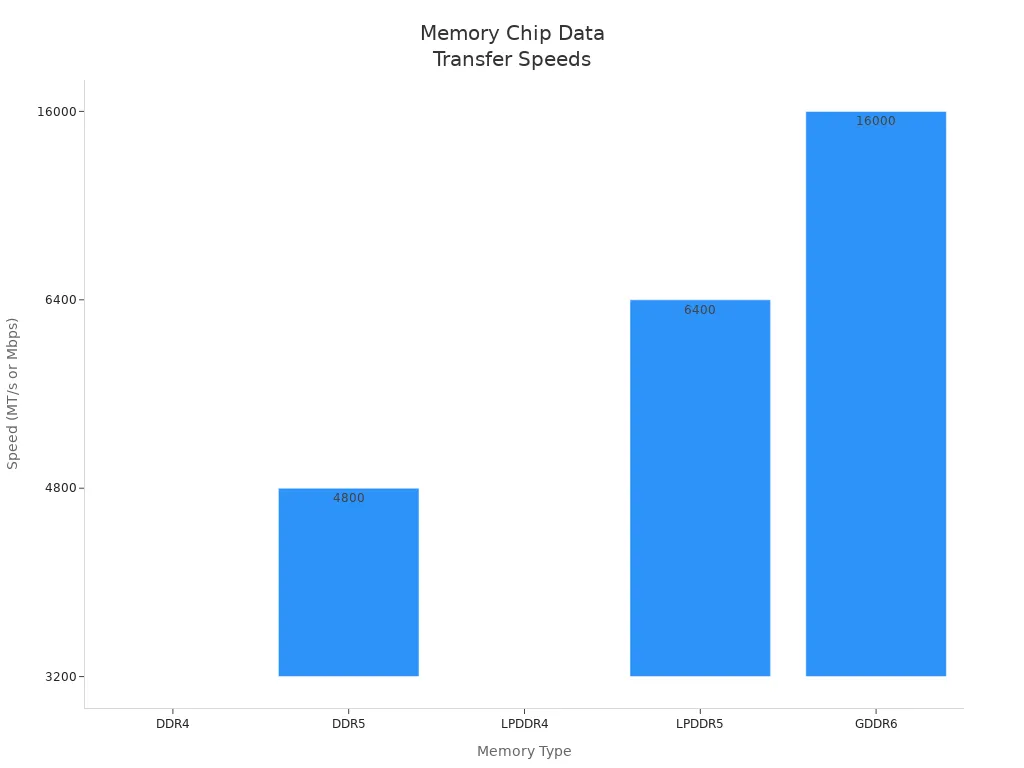
Note: Higher memory speeds help reduce lag and make devices feel more responsive, especially during heavy use.
Voltage
Voltage shows how much electrical power the memory chip needs to work. Most memory chips use standard voltages like 1.5V, 1.8V, 2.5V, or 3.3V. Lower voltages, such as 1.5V and 1.8V, help save energy and keep devices cooler. This is important for mobile devices and servers that need to run for long periods without overheating.
1.5V and 1.8V: More power-efficient, reduce heat, and are common in mobile and modern computing devices.
2.5V and 3.3V: Used in older or special systems, offer more stability but use more power and create more heat.
Using the right voltage keeps the chip stable and safe. Too much or too little voltage can damage the chip or make it unreliable.
Always check the voltage requirements before installing a memory chip to avoid damaging your device.
Interface
The interface is the way the memory chip connects and communicates with the rest of the system. Common interfaces for memory chips like the GD9FU4G8F3AMGl include DDR, LPDDR, and GDDR. Each interface has its own speed, power needs, and compatibility rules.
DDR4 and DDR5: Used in desktops, servers, and high-performance computers.
LPDDR4 and LPDDR5: Designed for mobile devices and embedded systems, focus on saving power.
GDDR6: Built for graphics cards and gaming systems, offers very high speed for demanding tasks.
The interface affects which devices the chip can work with. For example, a motherboard made for DDR4 cannot use DDR5 memory.
The physical shape and pin layout must match the system. Some chips use BGA or TSOP packages, and the number of pins must fit the motherboard.
ECC support is important for systems that need high data accuracy, like servers.
Choosing the right interface ensures the memory chip works smoothly with your device and delivers the best performance.
Features
Performance
Memory chips like the GD9FU4G8F3AMGl deliver high performance for demanding tasks. GDDR6 technology, which this chip likely uses, reaches speeds up to 16 Gbps per pin. This speed supports smooth graphics in gaming consoles, fast data processing in workstations, and real-time rendering for professional applications. GDDR6 chips use advanced interfaces, such as 32-bit and 64-bit widths, to move large amounts of data quickly. They often come in BGA packages, which help manage heat and keep the chip stable during heavy use. The table below shows how GDDR6 compares to other memory types in performance and application:
Category | Usage Scenarios | Characteristics | Advantages | Disadvantages |
|---|---|---|---|---|
GDDR6 | GPUs in gaming consoles, high-end gaming PCs, professional workstations, real-time rendering, machine learning | Up to 16 Gbps per pin, lower voltages, 32-bit and 64-bit interfaces, stackable for increased capacity | High bandwidth, power-efficient, enhanced performance, cost-effective compared to HBM | Higher latency, complexity in implementation, heat management |
GDDR6 memory chips operate reliably in a wide temperature range, from 0°C to +70°C for commercial use, which helps maintain performance in different environments.
Power Efficiency
Power efficiency is a key feature for modern memory chips. The GD9FU4G8F3AMGl uses lower voltage levels, which means it consumes less energy while processing data. This efficiency is important for mobile devices and laptops, as it helps extend battery life and reduce heat. Chips that run at 1.1V to 1.5V offer the best power savings, while higher voltages use more energy and can shorten battery life. The chart below shows how voltage levels affect power efficiency and battery performance:
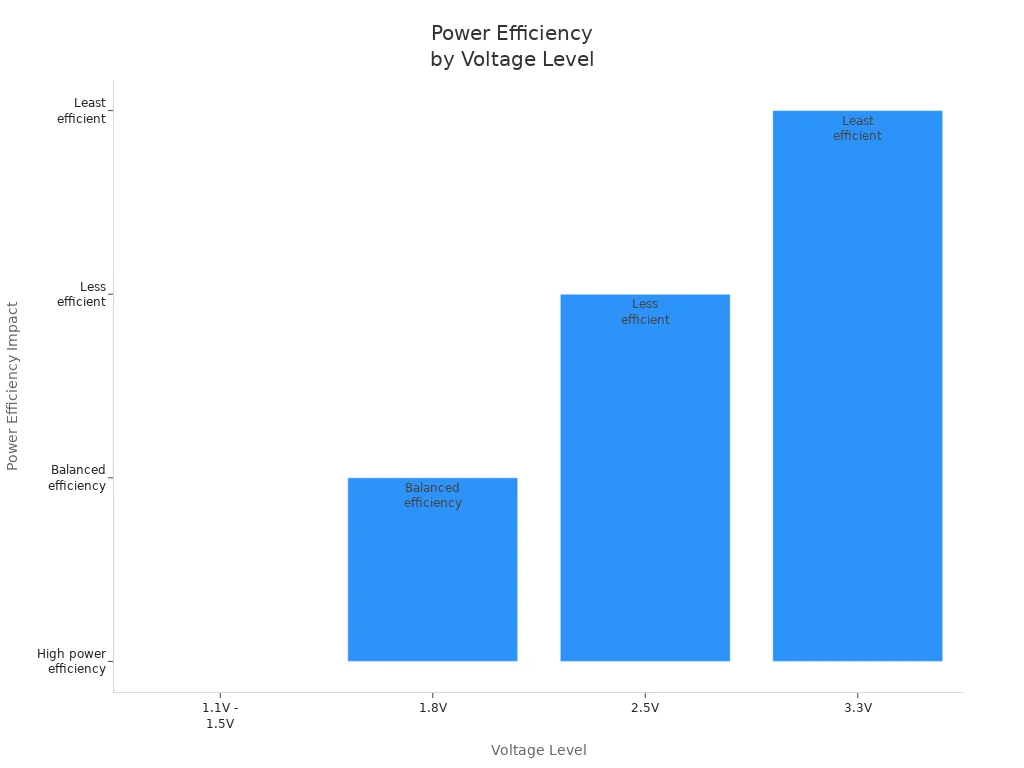
Devices with efficient memory chips stay cooler and last longer on a single charge, making them better for everyday use.
Compatibility
Compatibility ensures that a memory chip works well with the rest of the system. The GD9FU4G8F3AMGl must match the system’s chipset, form factor, and power supply. It should support the correct memory interface, such as GDDR6, and fit the physical design of the device. The chip’s voltage and speed must align with the system’s requirements. Systems that need error correction should check for ECC support. The chip must also work with the device’s operating system and firmware. Below is a list of important compatibility standards:
Chipset compatibility with the motherboard
Correct form factor and pin configuration
Matching power supply requirements
Supported memory interface standard
ECC support if needed
Operating system and firmware compatibility
Proper pin configuration
Suitable package type for heat and mechanical needs
Compatible voltage
Speed and temperature range that fit the system
Meeting these standards helps prevent problems and ensures the memory chip runs smoothly in any device.
Applications
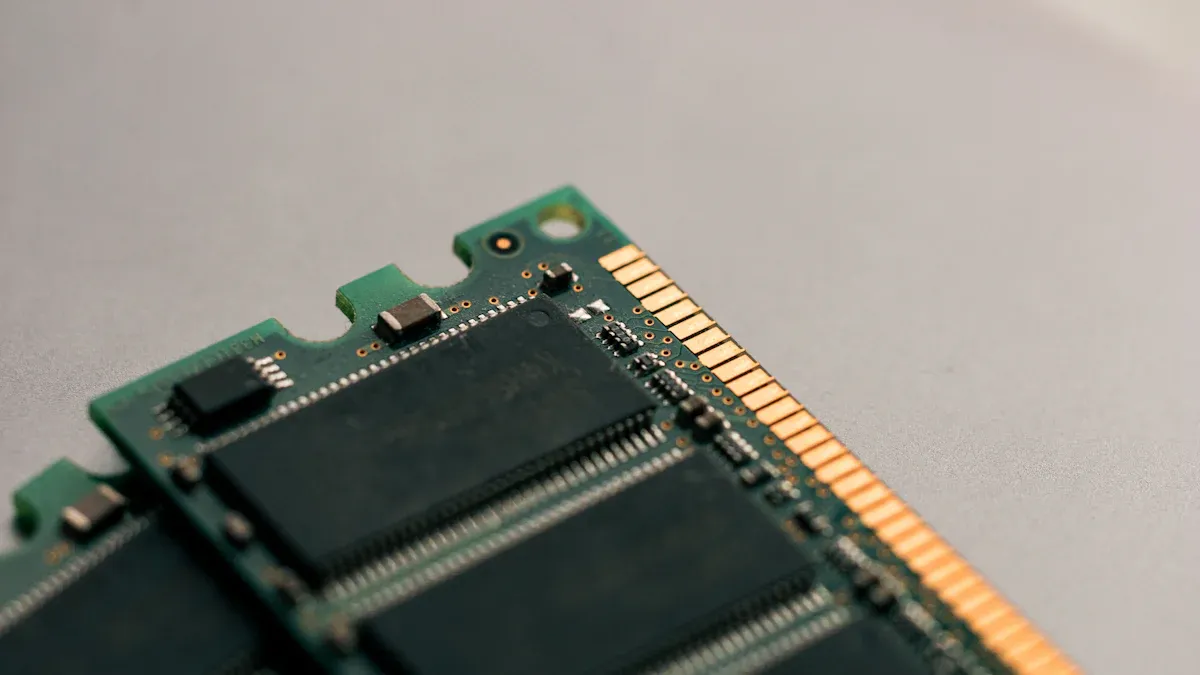
Consumer Devices
Memory chips power many popular consumer devices. These chips store data and help devices run smoothly. The most common devices include:
Mobile phones
Smart watches
Smart TVs
Home automation devices
Mobile phones use memory chips to load apps and save photos. Smart watches rely on memory for fitness tracking and notifications. Smart TVs need fast memory to stream videos and run smart features. Home automation devices, such as smart speakers and security cameras, use memory chips to process commands and store settings.
Consumer electronics and mobile devices represent the largest share of the memory chip market. In 2023, the semiconductor revenue for mobile and consumer segments reached $296 billion. Smart watches hold the biggest share among wearable devices, while smart TVs lead in consumer electronics by volume. Home automation devices account for the largest shipment share overall. The market for these devices continues to grow as more people use smart technology at home.
Tip: Devices with advanced memory chips offer better speed, more storage, and longer battery life.
Industrial Use
Industrial environments demand reliable memory chips. These chips must work in harsh conditions, such as extreme temperatures, vibrations, and dust. Industrial memory chips often operate between -40°C and +85°C. They use special packaging, like BGA or TSOP, to handle heat and physical stress.
Industries use memory chips in mission-critical systems. Examples include networking equipment, industrial controllers, healthcare devices, automotive computers, and aerospace systems. These chips support features like error correction code (ECC) to prevent data errors. Technologies such as System in Package (SiP) protect against shocks and electromagnetic interference. Industrial memory chips also use AutoRefresh and Dynamic Data Refresh to keep data safe.
Selecting the right chip ensures endurance and data accuracy. Industrial memory chips must meet strict quality standards to avoid downtime. The market for industrial electronics is growing, driven by automation and the expansion of IoT devices. The overall memory chip market is expected to grow at a compound annual rate of about 4.49% from 2024 to 2032.
Embedded Systems
Embedded systems use memory chips to control devices and process information. These systems appear in smart sensors, gateway devices, and human-machine interfaces (HMIs). Choosing the right memory chip depends on several factors:
Compatibility with system chipset and form factor
Power supply requirements (voltage levels)
Interface standards (DDR, LPDDR, GDDR)
ECC support for data integrity
Operating temperature range
Speed specifications
The table below compares common memory types for embedded systems:
Characteristic | SRAM | DRAM | NOR Flash | NAND Flash |
|---|---|---|---|---|
Volatility | Volatile | Volatile | Non-volatile | Non-volatile |
Density | Low | High | Medium | Very High |
Read Speed | Fastest (1-10ns) | Fast (10-100ns) | Medium (50-100ns) | Slow (25-50μs) |
Write Speed | Fastest (1-10ns) | Fast (10-100ns) | Slow (5-10μs) | Very Slow (200-500μs) |
Endurance | Unlimited | Unlimited | 10⁴-10⁵ cycles | 10³-10⁵ cycles |
Active Power | Medium-High | Medium | Low | Low |
Standby Power | Low | Medium (refresh) | Very Low | Very Low |
Cost per Bit | Highest | Medium | Medium-High | Lowest |
Best Use Case | Cache, high-speed buffers | Main memory | Boot code, firmware | Mass storage, SSDs |
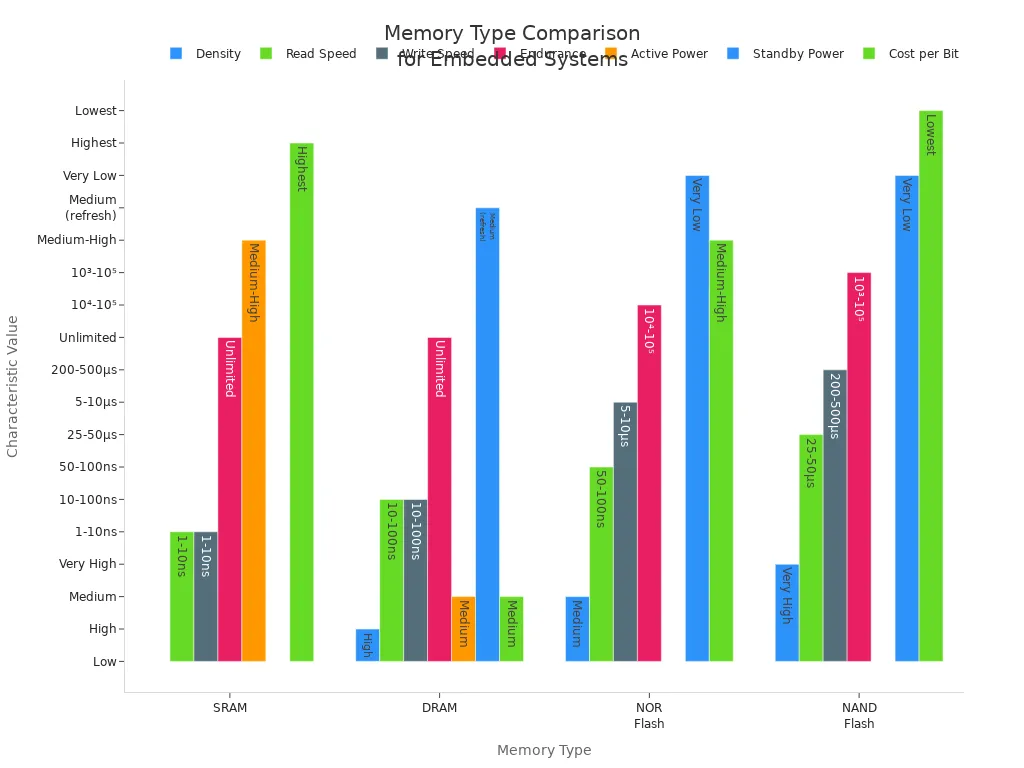
Embedded systems often choose LPDDR and NAND flash for power efficiency and cost savings. These chips must also work well with the device’s operating temperature and support error correction for reliable performance.
The GD9FU4G8F3AMGl memory chip helps devices store and process data quickly. Buyers should focus on several important features:
Data rate and bandwidth boost performance.
Memory size supports larger tasks.
Power efficiency saves energy.
Temperature tolerance keeps systems stable.
Feature | |
|---|---|
Speed | Faster speeds improve data access. |
Voltage | Lower voltage reduces power use and heat. |
Package | Form factor affects integration and cooling. |
ECC Support | Protects data in critical systems. |
Compatibility | Ensures smooth operation with other parts. |
Temperature Range | Higher tolerance means better reliability. |
Understanding these details helps users choose the right memory chip for their needs.
FAQ
What devices use the GD9FU4G8F3AMGl memory chip?
Many devices use this chip, including gaming consoles, laptops, smart TVs, and industrial controllers. Designers choose it for fast data handling and reliable storage.
How does memory size affect device performance?
Larger memory size lets devices run more apps and handle bigger files. Users notice faster speeds and smoother multitasking when devices have more memory.
Is the GD9FU4G8F3AMGl chip energy efficient?
Yes. This chip uses low voltage, which helps save power. Devices with this chip often stay cooler and last longer on battery.
Can users upgrade the GD9FU4G8F3AMGl chip themselves?
Most users cannot upgrade this chip. Manufacturers usually solder it directly onto the device’s circuit board. Only trained technicians can replace or upgrade it.
What should buyers check before choosing this memory chip?
Buyers should check compatibility, voltage, speed, and ECC support. Matching these features with the device ensures smooth operation and prevents damage.
See Also
Key Innovations Shaping Memory Chip Production In 2025
Understanding Static RAM Chips And Their Functionality
A Clear Guide To Communication Chips And Operations
